
Two small disks A and B of mass 3 kg and 1.5 kg, respectively, may slide on a horizontal, frictionless surface. They are connected by a cord, 600 mm long, and spin counterclockwise about their mass center G at the rate of 10 rad/s. At t = 0, the coordinates of G are
'
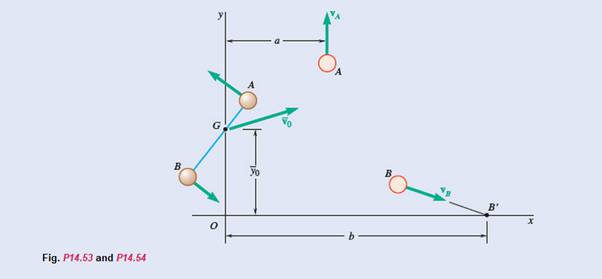
(a)
The velocities of disks A and B after the cord breaks.
Answer to Problem 14.53P
Explanation of Solution
Given information:
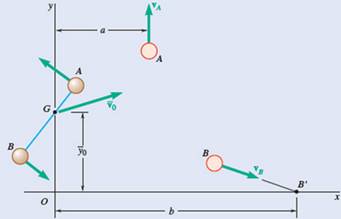
Mass of the disk A,
Mass of the disk B,
Length of cord
At t=0,
Co-ordinates of G are
Velocity
Distance
Firstly, calculate for initial condition.
The free body diagram for initial condition is as follows:
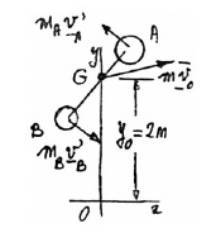
The distance G from points A and B,
And,
Now, considering linear momentum,
After breaking the disks moves counter clockwise about their mass centre G, at the rate of 10 rad/sec.
Hence, angular momentum of both the disc about G,
Again, angular momentum of both the disc about point O,
Here, the property of determinant
Now, kinetic energy of the component is,
Calculation:
After the cord is break then the free body diagram of both disc A and B.

Using conservation of mass of linear momentum,
Equation the coefficient of i :
Equation the coefficient of j :
Applying conservation of energy,
Substituting the values from equation (1) and (2);
By solving the above equation we get;
Hence, velocity of A,
And velocity of B,
(b)
The distance a from the y-axis to the path of A.
Answer to Problem 14.53P
Explanation of Solution
Given information:
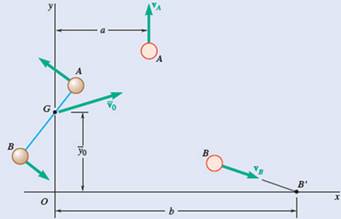
Mass of the disk A,
Mass of the disk B,
Length of cord
At t=0,
Co-ordinates of G are
Velocity,
Distance
Firstly, calculate for initial condition.
The free body diagram for initial condition is as follows:
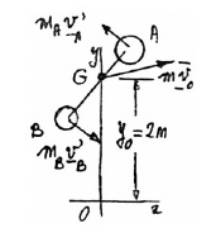
The distance G from points A and B,
And,
Now, considering linear momentum,
After breaking the disks moves counter clockwise about their mass centre G, at the rate of 10 rad/sec.
Hence, angular momentum of both the disc about G,
Again, angular momentum of both the disc about point O,
Here, the property of determinant
Now, kinetic energy of the component is,
Calculation:
After the cord is break then the free body diagram of both disc A and B.
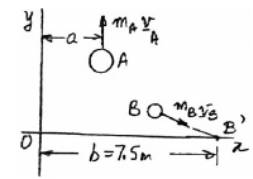
Using conservation of mass of linear momentum,
Equation the coefficient of i :
Equation the coefficient of j :
Applying conservation of energy,
Substituting the values from equation (1) and (2);
By solving the above equation we get;
Hence, velocity of A,
And velocity of B,
Now, Conservation of angular momentum about O,
Want to see more full solutions like this?
Chapter 14 Solutions
Vector Mechanics For Engineers
- A particle M1, weighing 2.4 Ibs, is tied to a thread and describes a circular path in a horizontal plane. The thread, of negligible mass, passes through a hole in the center of the circle and descends vertically. Another particle M2 is attached, weighing 5.0 Ibs, as shown in the figure. If M1 describes a uniform circular motion, with angular velocity w 3.1 rad/s, determine the radius R of the circumference in inches.arrow_forwardRequired information NOTE: This is a multi-part question. Once an answer is submitted, you will be unable to return to this part. Two small disks A and B of mass 3 kg and 1.5 kg, respectively, may slide on a horizontal, frictionless surface. They are connected by a cord 600 mm long and spin counterclockwise about their mass center G at the rate of 13 rad/s. At t = O, the coordinates of G are x = 0 and yo= 2 m, and its velocity is Vo= (1.2 m/s)i +(0.96 m/s)j. Shortly thereafter, the cord breaks; disk A is then observed to move along a path parallel to the yaxis and disk B along a path which intersects the x axis at a distance b-7.5 m from O. Determine the distance a from the y axis to the path of A. The distance from the y axis to the path of A is m. B'arrow_forwardTwo smooth disks A and B each have a mass of 0.5 kg. Both disks are moving with the velocities shown when they collide. Suppose that (vA)1 = 9 m/s , (vB)1 = 8 m/s. The figure shows two discs, A and B, moving toward the origin of a horizontal xy-plane, where they collide, so that their common tangent lies on y-axis. Disk A moves in negative x-direction with velocity left-parenthesis v subscript A right-parenthesis subscript 1. Block B moves from the third quarter with velocity left-parenthesis v subscript B right-parenthesis subscript 1, directed along an inclined line with a slope of four-thirds. Determine the coefficient of restitution between the disks if after collision B travels along a line, 30∘ counterclockwise from the y axis.arrow_forward
- A 1024-kg blue ball is dropped from an initial z-position of 5.4 x 106 m through the center of a planet with radius 6.3 x 106 m. If the mass of the planet is 37.7 x 1015 kg, measure the displacement of the ball at time t = 5 s?arrow_forwardASAParrow_forwardRod OA rotates counterclockwise at a constant angular rate 0-4 rad/s. The double collar B is pin-connected together such that one collar slides over the rotating rod and the other collar slides over the circular rod described by the equation r= (1.6 cos 6) m. Both collars have a mass of 0.65 kg. Motion is in the vertical plane. (Figure 1) Figure r=1.6 cos 9. 0-4 rad/s 0.8 m 1 of 1 Part A Determine the magnitude of the force which the circular rod exerts on one of the collars at the instant 0=45 Express your answer to three significant figures and include the appropriate units. ▸ View Available Hint(s) F= Value Submit μÁ Part B Previous Answers Units X Incorrect; Try Again; 5 attempts remaining Determine the magnitude of the force that OA exerts on the other colar at the instant @-45. Express your answer to three significant figures and include the appropriate units. View Available Hint(s)arrow_forward
- As shown in the picture below, a 40-kg diver is positioned so that his radius of gyration is 0.4m as he leaves the board with an angular velocity of 5 rad/s (Position 1). What is the diver's angular velocity when he changes his pose to Position2, altering his radius of gyration to 0.2m? Position 1 Position 2 CARarrow_forwardA uniform cylindrical turntable of radius 1.9 m and mass 30.0kg rotates counterclockwise in a horizontal plane with an initial angular speed of 4pi rad/s. The fixed turntable bearing is frictionless. A lump of clay of mass 2.25kg and negligible size is dropped onto the turntable from a small distance above it and immediately sticks to the turntable at a point 1.80m to the east of the axis. A. Find the final angular speed of the clay and turntable. B. Is the mechanical energy of the turntable-clay system constant in this process? C. Is the momentum of the system constant in this process? Explain your answer.arrow_forwardRod OA rotates counterclockwise at a constant angular rate θ˙ = 4 rad/s. The double collar B is pin-connected together such that one collar slides over the rotating rod and the other collar slides over the circular rod described by the equation r=(1.6cosθ)m. Both collars have a mass of 0.7 kg . Motion is in the horizontal plane. (Figure 1)arrow_forward
- Two identical giant flywheels are on 2 identical slopes at an angle alpha = 20 deg. One flywheel is rolling on its inside shaft of diameter d1 = 3 ft, and the second flywheel is rolling without slipping on its outside diameter d2 = 5 ft. They are both released from rest. The weight of the flywheel is W = 8 lbs Knowing that flywheel 1 attains a speed of v = 7.0 ft/s in t = [t] s, (if t doesn't show take any t between 5 and 10 sec) find the radius of gyration of the flywheels, following those steps: b. Find omega final c. Find the angular impulse at the point of contact between the shaft and the slope. d. Write the formula to find the final momentum. e. Solve for k, using the principle of angular impulse and momentumarrow_forwardA solid sphere of mass M and radius R rolls without slipping along a table at speed v. What is its kinetic energy? Mv2/5 Mv2/2 Mv2 3Mv2/2 7Mv2/10arrow_forward(a) Determine the z component of the angular momentum HP of particle A about point P using scalar notation. Suppose that mA = 3.4 kg. (b) Determine the z component of the angular momentum HP of particle B about point P using scalar notation. Suppose that mB = 4.2 kg .arrow_forward
 Elements Of ElectromagneticsMechanical EngineeringISBN:9780190698614Author:Sadiku, Matthew N. O.Publisher:Oxford University Press
Elements Of ElectromagneticsMechanical EngineeringISBN:9780190698614Author:Sadiku, Matthew N. O.Publisher:Oxford University Press Mechanics of Materials (10th Edition)Mechanical EngineeringISBN:9780134319650Author:Russell C. HibbelerPublisher:PEARSON
Mechanics of Materials (10th Edition)Mechanical EngineeringISBN:9780134319650Author:Russell C. HibbelerPublisher:PEARSON Thermodynamics: An Engineering ApproachMechanical EngineeringISBN:9781259822674Author:Yunus A. Cengel Dr., Michael A. BolesPublisher:McGraw-Hill Education
Thermodynamics: An Engineering ApproachMechanical EngineeringISBN:9781259822674Author:Yunus A. Cengel Dr., Michael A. BolesPublisher:McGraw-Hill Education Control Systems EngineeringMechanical EngineeringISBN:9781118170519Author:Norman S. NisePublisher:WILEY
Control Systems EngineeringMechanical EngineeringISBN:9781118170519Author:Norman S. NisePublisher:WILEY Mechanics of Materials (MindTap Course List)Mechanical EngineeringISBN:9781337093347Author:Barry J. Goodno, James M. GerePublisher:Cengage Learning
Mechanics of Materials (MindTap Course List)Mechanical EngineeringISBN:9781337093347Author:Barry J. Goodno, James M. GerePublisher:Cengage Learning Engineering Mechanics: StaticsMechanical EngineeringISBN:9781118807330Author:James L. Meriam, L. G. Kraige, J. N. BoltonPublisher:WILEY
Engineering Mechanics: StaticsMechanical EngineeringISBN:9781118807330Author:James L. Meriam, L. G. Kraige, J. N. BoltonPublisher:WILEY





